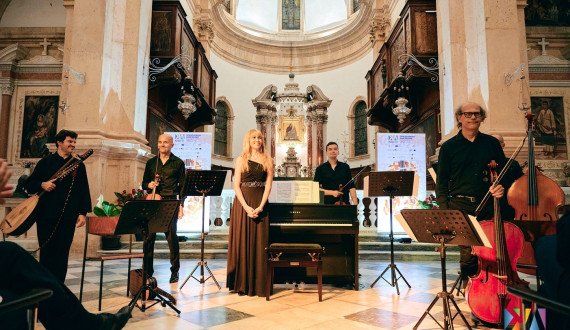From a Time Capsulle Directly to Baroque
Perceived as a sound phenomenon above all, a baroque piece of music should capture the attention of every performer who seriously wants to approach the way of its interpretation. As a result of numerous researches during the last century, today it is very possible to bring the authentic sound of the Baroque period closer to the modern listener, with all the specificities of authentic instruments, the variability of the musical text, the usual improvisational practice, and so forth. With all that in mind, as well as many years of significant concert practice, the members of the Italian Accademia Bizantina Ensemble presented the sound of Baroque at the KotorArt Don Branko’s Music Days. On Sunday, July 17, in the Church of Our Lady in Prčanj, they performed works by Italian and English composers with instruments modeled after instruments from the Baroque era.

Led by violinist and conductor Alessandro Tampieri, the Accademia Bizantina Ensemble also includes violinist Gabriele Pro, cellist Paolo Ballanti, then Giovanni Valgimigli who plays the violone, then Tiziano Bagnati who plays the lute and the baroque guitar, as well as the harpsichordist Chiara Cattani. The ensemble was founded in Ravenna in 1983, and after only a few years of their activity has been adhering to the Baroque style and form in their performances, without any modifications to the musical text and relying on the sounds of authentic instruments. At KotorArt, the ensemble, respectively, performed Giovanni Battista Reali’s La Follia, Baldassare Galupi’s Trio Sonata, Nicola Matteis’ Suite in E minor, Antonio Caldara’s Chaconne, Henry Purcell’s Chaconne, Pietro Antonio Locatelli’s Trio Sonata, and Antonio Vivaldi’s La Follia. When it comes to trio sonatas, a Baroque genre written in three parts, the artists used the acceptable and common technique in the Baroque of doubling the parts – usually the lower, bass part enriched with harmonies (basso continuo), so we listened to these works in the sumptuous sound of six instruments (instead of three).
The wealth of contrasts of homophonic and polyphonic texture, piano and forte dynamics, as well as the abundance of other features typical of the aesthetics of musical Baroque, such as virtuosity or continuous rhythmic beat, are sublimated through the interpretation of two follies by Venetian composers, Giovanni Battista Reali and Antonio Vivaldi. This specific and very important Baroque genre of variation form, based on a theme of an established harmonic pattern, was an inspiration for the artists to use wordplay and create the name of the concert – L’Arte della Follia da Venezia a Londra, emphasizing the literal meaning of the term follia – folly, in Italian.
The selection of the Accademia Bizantina Ensemble for this year’s festival program was a sophisticated move by KotorArt, because the ensemble presented the essence of the Baroque performing practice to the festival audience, as if from a kind of time capsule they brought out the live music of baroque churches, courts and squares.
Boris Marković
